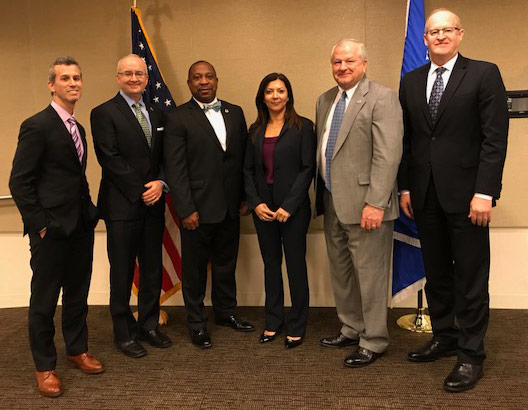Contact Us
To provide feedback on the Community Policing Dispatch, e-mail the editorial board at CPDispatch@usdoj.gov.
To obtain details on COPS Office programs, publications, and resources, contact the COPS Office Response Center at 800-421-6770 or AskCopsRC@usdoj.gov

U.S. Department of Justice
Office of Community Oriented Policing Services
Washington, DC 20530
 The new COPS Office STOP School Violence: School Violence Prevention Program (SVPP) provides up to $25 million in funding for state, local, and tribal units of government. This funding will be used to coordinate with law enforcement and schools to improve school safety with deterrence hardware, emergency notification technology, law enforcement training, and other evidence-based measures to support comprehensive school safety plans.
The new COPS Office STOP School Violence: School Violence Prevention Program (SVPP) provides up to $25 million in funding for state, local, and tribal units of government. This funding will be used to coordinate with law enforcement and schools to improve school safety with deterrence hardware, emergency notification technology, law enforcement training, and other evidence-based measures to support comprehensive school safety plans.
To prepare for evaluation of the solicitation requests, the COPS Office held an SVPP briefing in August, with school safety experts and practitioners discussing a broad topic of issues. The first speaker was Max Schachter, founder and CEO of Safe Schools for Alex, who lost his son during the mass shooting at Marjory Stoneman Douglas High School on February 14, 2018. Mr. Schachter discussed a number of measures to improve emergency response protocols in schools, hardware and technology to increase the safety of students and staff during an incident, and development of a national school safety policy similar to fire safety standards. Schachter advocates for the protection of children and teachers through his role on the Marjory Stoneman Douglas High School Public Safety Commission.
Mo Canady, Executive Director for the National Association of School Resource Officers (NASRO), followed Mr. Schachter to present information on a comprehensive approach to school safety. He reviewed the physical security and target hardening of school buildings and campuses, CPTED (Crime Prevention Through Environmental Design), the psychology of school safety, technology such as video surveillance and visitor entry tracking systems, and partnerships between law enforcement and other first responders and school personnel and the community. NASRO advocates for School Resource Officers (SROs) in every school as part of a comprehensive safety plan.
School Resource Officers
A school resource officer (SRO) is a full-time law enforcement officer with sworn law enforcement authority, trained in school-based policing and crisis response, assigned by the employing law enforcement agency to work with the school using community-oriented policing concepts.
Source: NASRO, Standards and Best Practices for the School Resource Officer Programs (Hooverville, AL: NASRO, 2018), https://nasro.org/cms/wp-content/uploads/2013/11/NASRO-Standards-and-Best-Practices.pdf
Clarence Cox III, President (retired) of the National Organization of Black Law Enforcement Executives (NOBLE), spoke next about his expertise in school-based law enforcement and important factors to consider in comprehensive planning. He raised evaluation questions that should be answered when purchasing communication equipment, visitor management systems, and surveillance technology. He stressed the importance of having a ‘system of care’ for students that provides a network of services to help struggling teens and children. Cox recommended that overall, evaluators be thoughtful about community partners working to make children safe and the safety policies and procedures that schools implement.
The final presenter was Dr. Lina Alathari, Chief of the U.S. Secret Service National Threat Assessment Center (NTAC), who spoke on threat assessments, the management of threats in schools, and the continuum of school safety. The NTAC just released a new publication, Enhancing School Safety Using a Threat Assessment Model: an operational guide for creating a violence prevention program in schools. The program aims to allow school personnel to identify possible threats and avert violence through training, a central reporting system, and the development of a multidisciplinary threat assessment team.
The briefing was attended by COPS staff and leadership, as well as other DOJ component staff, including partner agency the Bureau of Justice Assistance (BJA). The SVPP program funding is made available through the STOP School Violence (Students, Teachers, and Officers Preventing School Violence) Act of 2018. It provides $50 million in FY2018 for the BJA to fund multimedia projects, mental health training, and development of school threat assessments. For more information, visit COPS Office Grants & Funding.
Elizabeth Simpson
COPS Office
Subscribe to Email Updates
To sign up for monthly updates or to access your subscriber preferences, please enter your email address in the Subscribe box.






